Without Borders: Cuban Doctors in Latin America and the Caribbean in the Context of COVID-19 (I)
Msc. Orietta Hernández Bermúdez, Lic. Mayra Bárzaga García
September 25, 2020
Specials, Health No Comments
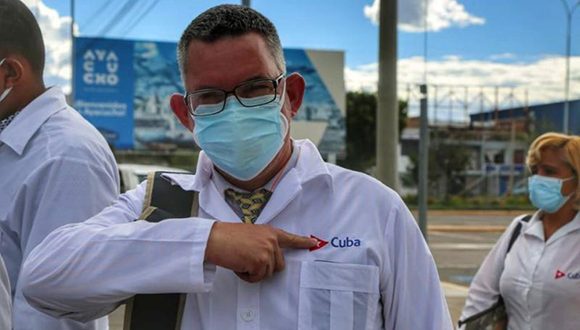
One of the 85 Cuban health professionals who help in Peru. Photo: Photo @ EmbaCubaPeru.
I am a son of America and I owe myself to her.
Jose Marti
The Latin American and Caribbean region continues to be the most unequal region in the world in terms of income distribution among its population, with an average Gini index of 0.465 in 2018. The SARS Cov-2 virus does not take into account the conditions social to infect a person. However, belonging to a social status does make you more vulnerable to acquiring it and developing the disease. The access and quality of health systems, working conditions, abandonment of rural areas, access to safe water, educational levels, overcrowding in poor neighborhoods or access to technology, increase the level of exposure contagion and limitations to protect themselves.
According to OXFAM “measures as basic as washing hands or avoiding physical contact are difficult for the 21% of the Latin American urban population who live in slums, informal settlements or inadequate housing. 81% of the region’s population is urban. In marginal neighborhoods, basic services are a luxury, many homes do not even have access to water within them. In 2018, 13.5% of Latin American households did not have access to water sources at home, and in rural areas this percentage increased to 25%. Overcrowding is inevitable in these settlements with more than 3 people per bedroom ”. [one]
The numbers speak for themselves. In Latin America and the Caribbean, 20% of the population concentrates 83% of the wealth. The number of billionaires in the region has increased from 27 to 104 since 2000. During the Covid-19 pandemic, the fortune of the 73 billionaires in Latin America increased by 48.2 billion dollars. [2] In contrast, extreme poverty is increasing. In 2019, 66 million people, that is, 10.7% of the population lived in extreme poverty. More than half of its workers (53.1%) were employed in the informal sector and poverty and inequality had the face of a woman, according to data from the Economic Commission for Latin America and the Caribbean (ECLAC).
“The region is also marked by racial, ethnic and territorial inequalities and those related to the different stages of the life cycle, which means that various population groups continue to be left behind,” warned Alicia Bárcena. [3] The senior United Nations official warned that Latin America and the Caribbean is currently the global focus of the COVID-19 pandemic, with dramatic repercussions not only in terms of health, but also because it represents a great setback in terms of regarding the eradication of poverty.
According to the estimates indicated by ECLAC, the effects of the pandemic will generate the largest recession that the region has suffered since 1914 and 1930, with a projected growth of -5.3%, a significant deterioration in labor indicators in 2020 that would generate almost 12 million more unemployed in the region and an increase of almost 28.7 million more poor than in 2019, for a total of 214.7 million people living in poverty in the Latin American region (34.7% of the total population [4] . Furthermore, it is foreseeable that extreme poverty will increase by 2.6 percentage points (15.9 million more people), affecting a total of 83.4 million people who are also at risk of falling into a food crisis. [5]
When the first case of the pandemic was reported in Brazil, on February 26, 2020, a tsunami of deaths began in the region. Since then, COVID-19 has spread to the 54 countries and territories of the Americas region. The epicenter of the pandemic has moved to the region of the Americas, in which, as of August 3, 2020, 9,764,672 confirmed cases ( 111,200) had been reported, 54.06% of the total cases reported in the world, with 365 688 deaths ( 2089) for a fatality of 3.74% (-0.01) [6] . In general, there is an increasing trend in incidence and deaths in the region. Five countries (Brazil, the United States of America, Chile, Mexico and Peru) are among the ten with the highest number of confirmed cases and / or deaths worldwide.[7]
The health crisis exposed the weaknesses of the region’s public health systems. Unfortunately, in Latin America and the Caribbean health systems, public, universal and of quality are non-existent. Public investment in health averages 2.2% of GDP, roughly half of what the WHO recommends. Governments invest an average of $ 600 per capita each year in ensuring the health of the Latin American population, 21% of what OECD countries invest. There are an average of 23 hospital beds and 18 doctors for every 10,000 inhabitants, approximately half the average in OECD countries. This is the reason why the underserved public hospitals collapsed and contagion levels spread even further.
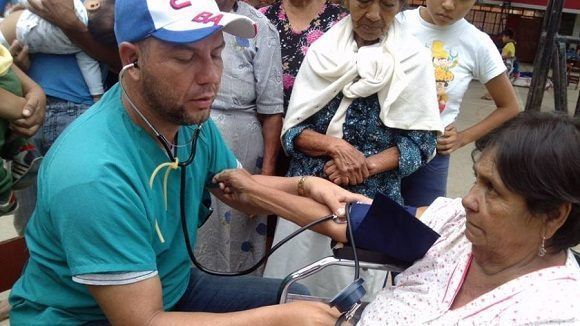
Cuba, in the Latin American and Caribbean region, has set a precedent in terms of social development. Photo: Archive.
Cuba, in the Latin American and Caribbean region, has set a precedent in terms of social development. In the rest of the continent, the forced application of neoliberalism in the final decades of the last century, caused the deepening of the political crises that caused the illegitimacy and ungovernability of the constitutional authorities and a wide questioning of the postulates of democratic representativeness in its “principles intermediaries ”. In some countries such as Venezuela, Ecuador and Bolivia, during the nineties and early twenty-first century, a reconfiguration of socio-political structures occurred that allowed the inclusion and visibility of historically marginalized social classes.
In the last three years this reality has radically changed and an ultra-neoliberal wave invades most of the region, with governments eager to consolidate an economic model that destroys everything achieved in the decade won by Latin American progressivism.
Cooperation of Cuba with Latin America in the public health sector
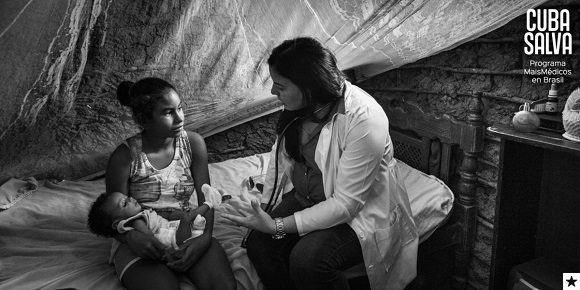
Cuban doctors in Brazil. Photo: Araquem Alcántara
International organizations such as the WHO, the United Nations Children’s Fund (UNICEF) or the UN itself recognize the largest of the Antilles as the only Latin American country with one of the best health systems in the world.
Since the beginning of the Cuban Revolution in 1959, the Cuban public health model also became paradigmatic due to its outstanding component of international cooperation. The first Cuban medical aid was carried out in 1960. In that year Chile had suffered an earthquake and Cuban doctors arrived there to treat the victims. The decision was made known by the Commander in Chief, Fidel Castro, at the opening ceremony of the Faculty of Basic and Pre-clinical Sciences “Victoria de Girón”.
This medical aid and in other spheres continued in a sustained way; despite the fact that on February 3, 1962, the Law of Commerce with the Enemy was put into practice, which proclaimed an embargo on trade between the United States and Cuba. Since then, a succession of laws has intensified this scenario and the mark of the economic and commercial siege has been present in all spheres of Cuban life, especially in medical collaboration. For the Latin American case, it is very significant because it limits commercial and financial activity in the area closest to the island.
Hurricanes Mitch and George, in 1998, in Central America and the Caribbean, caused unprecedented human and material losses in the region, and at the request of various governments for humanitarian aid, Cuba provided its support and collaboration in the reconstruction of these countries. More than 2,000 professionals traveled to Central America to collaborate for free.
In December 1998 the first Medical Brigade was transferred to Haiti. From this moment on, the idea was conceived, by President Fidel Castro, in December 1998, of creating the Latin American School of Medicine (ELAM). On February 27, 1999, the first 1,933 students arrived with free scholarships from 18 countries. The conception of this school was to train professionals who are willing to return to their communities of origin to provide primary health care. The Comprehensive Health Plan began to be executed, structured to respond to the needs of the Central American region, which was subsequently extended to the entire world. As part of this strategy, ELAM would train professionals from these countries.
By 1999, Cuba had 363,000 health professionals trained and working in the national health system. Between 1963 and 2001, more than 156,280 of these professionals had collaborated in more than 140 countries; 75% of all UN countries; of them, 24 countries of the Latin American region. As of the year 2000, important steps were taken that consolidated and diversified the effectiveness of Cuban medical collaboration, mainly in Latin America and the Caribbean. It is worth highlighting among them the impulse and development of the Bolivarian Revolution in Venezuela, which led to the appearance of the Special Programs modality, such as Barrio Adentro, in 2003.
The creation of ALBA-TCP (2004) had a significant importance in the history of Cuban medical cooperation. This integration mechanism was founded in 2004, but its origin dates back to 2001 when, at the III Summit of Heads of State and Government of the Association of Caribbean States, then-President Hugo Chávez proposed the creation of an integration project and cooperation that would show the other governments of the region the real possibility of creating an alternative mechanism to the logics imposed by the relations of domination that historically subordinated Latin America and the political systems of its Nation-States to the conditioning of the centers of power, especially the United States.
From the very beginning of the first period, the ALBA-TCP promoted the norms of Postliberal Regionalism, and its three returns, the Returns of the State, the Return of the Social Agenda and the Return of the Development Agenda. In the words of the Spanish academic José Antonio Sanahuja, these three returns have a historical explanation, since “the crisis of regional integration and in the model of Open Regionalism coincides with a new wave of proposals that point to a redefinition of regionalism and integration.” [8]
With the III Summit, Bolivia’s participation as a member country of the organization began. At that meeting, the signing of the Commercial Treaty of the Peoples (TCP) was also established, and the foundations of the joint medical cooperation of Cuba and Venezuela with the new member were defined . With the summits of 2007, the expansion stage of the organization began with the entry of Nicaragua under the newly elected Sandinista government. This led to the expansion of Petro Caribe’s association capacities with the Central American economies.

Cuban doctors with Venezuelan patients, Venezuela 2005. Photo Roberto Chile.
In fact, the document of Accession of Nicaragua as a new member was useful to reaffirm the conception of the principles of South-South cooperation that would identify the organization in its strategic approaches. In this sense, it was argued that overcoming the neoliberal model and its effects in the region implied a strategic alliance between the states and peoples of Latin America and the Caribbean, based on the principles of solidarity, cooperation, complementation and mutual aid, and based on the rescue and valuation of our identity, participatory democracy and economic development with equity [9] .
During 2008 and 2009, new members joined the organization, such as Dominica and Honduras in 2008, Ecuador, Saint Vincent and the Grenadines, and Antigua and Barbuda in 2009. It was not only expanded into the Caribbean, which meant a direct achievement of the cooperation policies linked to Petro Caribe, ALBA Alimentos, and Health Missions, but also incorporated South American States that had previously maintained indirect support for this initiative.
The ALBA-TCP allowed the development of both the policies applied by the governments to improve the quality of life of their societies, as well as the implementation of multilateral strategies, especially related to the ALBA-TCP, which allowed the articulation of governmental capacities. with the purpose of stimulating international cooperation.
The concept of complementarity acquired relevance in this mechanism to the extent that it allowed integration on the basis of interdependence, but not on power relations. This issue is evidenced above all in four fundamental axes: the one referred to educational programs, health programs, economic and commercial exchanges and energy agreements.
Regarding the programs related to ALBA-Health, it is important to note that this is one of the main achievements of ALBA-TCP as a multilateral mechanism. One of the added values has been the experience of Cuba, which shows a highly professional health system with a substantial development in primary care and disease prevention mechanisms, as well as community medicine. With this same logic, the organization had increased the social missions of the health function, such as the Barrio Adentro I and II Mission, in the case of Venezuela, and the Miracle Mission, carried out in the ALBA-TCP countries, but also in other areas of Latin America and the Caribbean, specifically in countries outside this hemisphere.
Another of the processes incorporated was the training of new professionals with the implementation of the Latin American School of Medicine, initially based in Cuba, but later extended in its infrastructure to Venezuela.
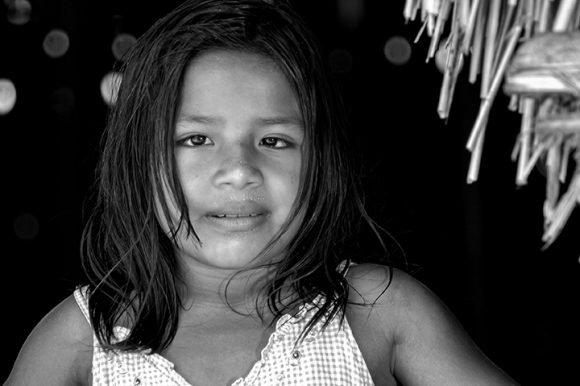
Venezuelan girl benefited by the Miracle Mission. Photo Roberto Chile.
According to data from the Pan American Health Organization (PAHO) in its report on the Health Situation in the Americas. Basic Indicators 2013 , in the comparison between the periods 2000-2004 and 2005-2009, a reduction is observed in the indicators of deaths related to treatable causes. In this sense, the ALBA-TCP countries showed favorable balances, however, their progress corresponded to the trend of other nations in the region that are not members of the organization.
This may be due to factors of higher social spending related to health and a more welfare focus of the State. Nicaragua presented a slightly negative balance, while Venezuela, Bolivia, Ecuador and Cuba, showed favorable projections. Something similar happened with island states like Antigua and Barbuda, where there was a positive evolution of health programs. [10]
With regard to the coverage and immunization indicators, it was perceptible that the results were disparate in some cases such as Venezuela, where it had been possible to increase human resources. However, this was not yet effectively translated into immunization mechanisms among minors. At the same time, Nicaragua had fewer human resources; however, social and health prevention mechanisms such as immunization of diseases to the child population were effective. Regarding the Caribbean population, both Saint Lucia and Saint Vincent and the Grenadines showed favorable balances in these lines. Something similar happened with Antigua and Barbuda. [eleven]
Even with the existing structural flaws, the organization shows a logic of internal cooperation that encourages an increase in health indicators. In this sense, the social and medical missions have led to a collective increase in life expectancy, placing the average of the ALBA-TCP countries at 73 years.
The statistical data provided by the official website of the organization shows a general decrease in infant mortality. In Bolivia, where mortality of this type was 66% at the beginning of 2000, it has achieved a reduction of close to 15%, although the rate remains at a considerable figure. Nicaragua has also achieved a reduction of 15% within this indicator, Ecuador 10 percent, Saint Vincent and the Grenadines 10%, Cuba 5%, Venezuela 8% and Antigua and Barbuda 6%. Other health strategies such as the Miracle Mission led to a notable increase in the number of visually impaired people who were treated. [12]
The work of ALBA-TCP as a regional integration mechanism has been decisive for the promotion of Cuban medical cooperation in the American continent. Its principles of cooperation between the peoples, as an alternative that strengthens them and makes them sovereign, capable of growing from complementarity, has not been well seen by the regional right and the United States, who have led a neoliberal offensive with new methods to do the progressive governments of the region fall one by one and thus weaken ALBA.
The constant economic sanctions against Venezuela have undoubtedly weakened the organization’s strongest economic pillar, seriously affecting the financing of health missions and programs. At the same time, the right-wing movement of progressive governments has become an adverse scenario for the development of Cuban medical collaboration, even being forcibly interrupted in some countries of the region.
Evolution of Cuban medical collaboration in Ecuador
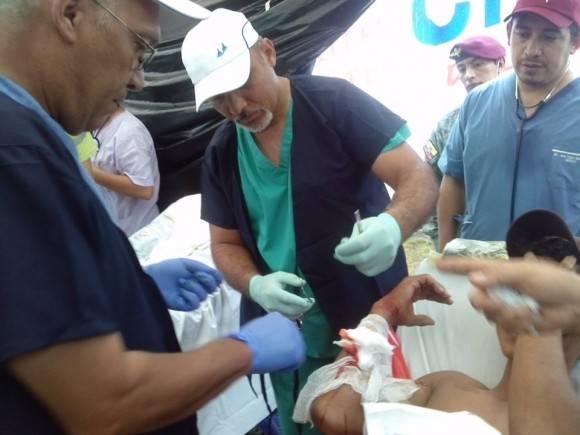
Cuban medical brigade in Ecuador. Photo: Dr. Enmanuel Vigil
The history of Cuban medical collaboration in Ecuador dates back 37 years (1992-2019). Cuba has provided assistance in emergency situations and disasters in Ecuador, for example, in 1986 due to heavy rains; in 2001 due to the dengue epidemic; in April 2016: care for the victims of an earthquake.
In June 2006, a cooperation agreement was signed for the start of “Operation Miracle”, with the participation of 153 collaborators, distributed in 3 hospitals. Through this program, 168,543 surgeries were carried out, of them 4,609 for cataracts and 118,575 for pterygium. All these operations were performed free of charge and in case more delicate operations were required, the patients were transferred to Cuba, free of charge as well.
In January 2009, on the occasion of the official visit of then President Rafael Correa Delgado to Cuba, the Framework Agreement for Cooperation in health matters was signed between the two governments. On June 11 of the same year, the Inter-Institutional Cooperation Agreement was signed between the then Ecuadorian Vice President Lenín Moreno Garcés and the Ministry of Public Health of Cuba, to carry out the psycho-social, pedagogical and clinical genetic study of people with disabilities. known as the Solidarity Mission “Manuela Espejo”.
During this program, 825,576 people were treated, of whom 35,257 were specialized neurophysiology and otorhinolaryngology consultations. 21 62 patients underwent clinical genetics studies, care that was carried out for the first time in the country.
In 2013, the contract was signed with the Ecuadorian Social Security Institute (IESS), through which 293 Cuban doctors from different specialties provided medical assistance in 52 units of this Institute.
From the beginning of the medical collaboration in this country until November 2019, a total of 3,565 Cuban health professionals provided their services in Ecuador. 6,749,666 medical consultations were carried out, 212,360 surgical interventions, 3,548 deliveries were attended and 100,084 doses of vaccination were applied. It is worth noting that Cuban professionals were in the poorest areas of the country, including, in an unprecedented way, medical care for indigenous communities in the Ecuadorian Amazon. 2 093 young Ecuadorians graduated as health professionals in Cuba.
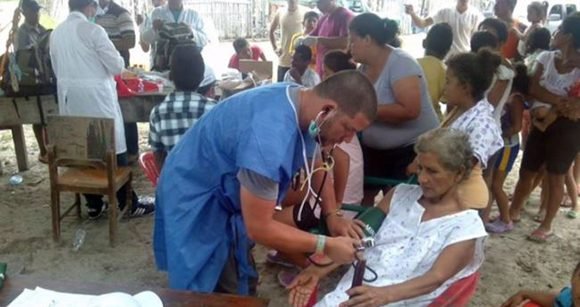
Cuban doctors in Ecuador. Photo: Enmanuel Vigil / Facebook.
Despite the results of the work of the Cuban Medical Brigade in 2018 in the country, the government of President Lenin Moreno terminated the Collaboration Agreement in November 2019. That same month, Cuba and Ecuador signed the Act that terminated 6 Specific scientific cooperation and technical assistance agreements, existing between the Ministries of Health of both countries since 2009. According to the signed minutes, the Ecuadorian authorities alleged economic reasons for terminating and not renewing these agreements. In accordance with the signed minutes, both parties recognized the results achieved in compliance with the aforementioned Agreements in the fields of epidemiology, transplantology, physiatry and rehabilitation, imaging and radiology, ophthalmology and angiology.
Cuba expressed the interest that the Ecuadorian Health authorities guarantee the required follow-up to the patients cared for by the Cuban Medical Mission. The 382 Cuban collaborators, who had provided their services in 23 of the 24 provinces, withdrew from the country with outstanding results in 2018: [1]
- 1,189,840 patients seen by Cuban specialists.
- 52,351 received rehabilitation.
- 17,992 surgeries, 10,466 ophthalmic and 5 30 of them for cataracts, which returned or improved vision in people with preventable blindness.
- 60 transplants performed for a cumulative of 211, with 94 percent survival five years after transplants (173 adults and 38 pediatric).
- More than 231,000 physiatry consultations, 47,438 imaging, 11 74 angiology, and 49,446 ophthalmology performed as part of the agreement with the Ministry of Public Health and the 49,446 cases seen under the agreement with the Ecuadorian Institute of Social Security .
- 13 117 consultations and 4 236 hemodialysis reported in compliance with the Nipse agreement.
- 81 673 consultations and 70 063 field work, under the teaching agreement with the Universidad Católica de Santiago de Guayaquil.
Notwithstanding the termination of the Agreement, the Declaration of the Cuban Foreign Ministry of December 5, 2019 reaffirmed Cuba’s willingness to collaborate: “The Ministry of Public Health of the Republic of Cuba ratifies the will to continue providing collaboration in this brother people , which ceases at this time as a result of a decision of the Ecuadorian government. The peoples of Our America and the rest of the world know that they can always count on the humanistic and supportive vocation of Cuban professionals. [two]
The United States’ persecution against Cuban medical cooperation began in Latin America and forced the cessation of cooperation programs in Brazil, Ecuador, and Bolivia. This policy has been implemented in the context of the administration of Donald Trump and breaks with the conversations initiated between Cuba and the administration of its predecessor Barak Obama. The governments of Barak Obama and Raúl Castro in December 2014 promoted the beginning of the normalization process between Cuba and the United States.
Added to the persecution initiated by the republican administration is the action combined with the threat of sanctions against Cuban leaders and pressure against recipient states to dispense with it. This campaign is led from the White House National Security Council, Florida Republican Congressmen and the State Department.
This scenario has led to accuse the island of practicing “modern slavery” and “human trafficking” through the use of health personnel who work in other countries ” [3] . The OAS participates in this persecution of health collaborators, accusing Cuba of “alleged crimes against humanity.” President Trump and the State Department, in their 2019 Report on Human Trafficking, denigrated Cuba’s international medical cooperation and, a month later, imposed visa-restricting sanctions on Cuban officials linked to medical missions.
The Agency for International Development (USAID) and the Department of State have directed efforts in all the governments of the region and in May 2019, the United States Embassy in Ecuador requested detailed information on the agreements and services of Cuban aid workers. Five months later, the Ecuadorian government terminated them, immediately despite their imminent expiration, citing economic reasons.
In October 2019, the Ministry of Foreign Affairs of Ecuador requested to know the purpose of the trip to that country of Cuban citizens carrying diplomatic and official passports. Later, the Minister of Government declared that several Cubans, associated with the cooperation agreements, participated in the protests that the Ecuadorian people were leading against the application of neoliberal measures . The Declaration of the Foreign Ministry of Cuba confirms that: as has been proven, no Cuban was a participant or organizer of these massive popular demonstrations and not a single official or diplomatic passport was misused. The manipulators have not been able to present a single piece of evidence.
Ecuador and COVID-19
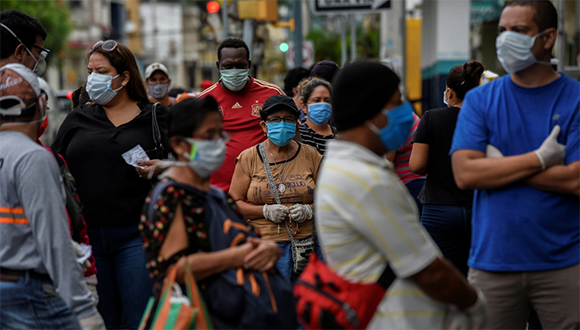
A row outside a pharmacy in Guayaquil, Ecuador. Photo: Santiago Arcos / Reuters.
The health crisis caused by the COVID-19 pandemic reached Ecuador in the midst of an unfavorable economic and social situation for the vast majority , as a consequence of the measures implemented by the government of Lenin Moreno, who is the protagonist of one of the most political crises complexes in the country.
The Government of Ecuador reported on July 10, 2020, 783 new cases of covid-19. According to the report issued by the national Emergency Operations Committee (COE) in Ecuador, 65,801 are reported infected by the virus and 65,018 patients with the disease. In addition, 8,272 deaths in the context of the pandemic. 4,983 deaths due to the disease and another 3,289 due to suspicion; 51 more deaths than on July 9. [one]
Unfortunately, Ecuador has the highest death rate in the world caused by this pandemic, according to an analysis by the British newspaper Financial Times [2] . The outlet calculated how many excess deaths (above the historical average) have been registered in different countries, so far in 2020, and compared those figures with their populations. Ecuador appears first in the ranking. According to this analysis, Ecuador registered 21,500 excess deaths until June 17. This means a rate of more than 1,000 excess deaths per million inhabitants.
In an analysis carried out by the newspaper EL UNIVERSO on the deaths registered in the Civil Registry in statistics that include deaths not only from COVID-19, but from all kinds of causes; found that between March 1 and June 15 of this year, 20,373 deaths were registered above the average of the previous two years. The newspaper clarifies that this figure may increase, since many deaths are registered even weeks late. [3]
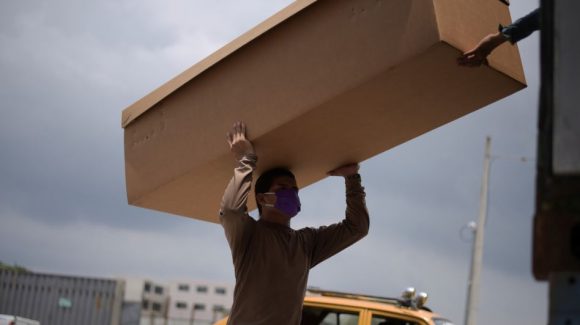
A man carries a cardboard coffin outside a cemetery in Guayaquil, Ecuador, on April 7, 2020. Photo: Reuters.
The emergency of the pandemic, managed erratically by the government, has seriously compromised its ability to safeguard the lives of its citizens, giving the impression that it leaves them defenseless in the face of the health crisis. In unison, an acute political crisis occurs in the country, linked to measures taken by the Executive and the Legislature with catastrophic consequences for the labor rights of workers and for the people, such as the Humanitarian Emergency Law , which is highly questioned from the social and the opposition.
In the almost three months of the presidential decree of a state of emergency, which streamlines public procurement by relaxing prior controls, hundreds of irregularities have been uncovered in the purchase of medical materials such as masks, COVID-19 tests or transport bags corpses ; which offers indications of a structural corruption that splashes from former president Abdalá Bucaram, to assembly members of the ruling party.
According to Reuters, in a survey carried out in 10 Latin American countries, the management of President Lenín Moreno’s health crisis has only 14.7% support. [4] 64.1% of Ecuadorians state that their image of the Moreno government worsened since the pandemic began. Moreno is the worst evaluated president among ten heads of state in Latin America.
Seven out of ten Ecuadorians (71.1%) rate it badly or very badly, one in ten does not know (9.8%) and only two out of ten (19.1%) evaluate it positively, according to the Latin American monitor carried out by the company TrespuntoZero Investigación Latam. [5] The measurement also makes it clear that people do not trust the public health system. Eight out of ten Ecuadorians consider that Ecuador is worse or equally ill prepared than the other nations in the region to control and prevent the coronavirus . Eight out of ten express little or no confidence in the ability of the health system to face the pandemic.
For the president of the Ecuadorian Medical Federation, Santiago Carrasco, this mistrust is the result of allegations of corruption that have been made public. “Corruption is involved in the purchase of medicines, in the acquisition of equipment. Unfortunately, the people who have to manage health policies are not prepared, they are people without expertise, people without knowledge ”. [6] According to the TrespuntoZero consultancy , 90.7 of those surveyed consider that the government is being corrupt; only 9.3% consider that it is not. As of July 10, the course of the epidemic shows signs that worse moments can be expected.
Notes:
[1] Government of Ecuador registers 783 new cases of covid-19 this July 10, 2020; Deaths reach 8,272 in the context of the pandemic. EL COMERCIO newspaper, Emergency Operations Committee (COE), July 10, 2020.Available at: https://www.elcomercio.com/actualidad/gobierno-ecuador-nuevos-contagios-covid19 .html
[2] Coronavirus tracked: the latest figures as countries start to reopen . Financial Times, July 13, 2020.Available at: https://www.ft.com/content/a26fbf7e-48f8-11ea-aeb3-955839e06441
[3] Paúl Mena Mena . Coronavirus in Ecuador: 20,400 deaths above the historical average during the pandemic. June 21, 2020.Available at: https://www.eluniverso.com/noticias/2020/06/21/nota/7879953/coronavirus-ecuador-20-400-muertes-sobre-promedio-historico-durante
[4] Uruguay, Paraguay and Argentina, the countries that best fight the pandemic in Latin America; Brazil, the worst: poll . Reuters, Buenos Aires, July 3,2020.Availableat: https://lta.reuters.com/articulo/salud-coronavirus-latam-encuesta-idL TAKBN2441RD-OUSLT
[5] Ecuador, the worst evaluated in the region on the management of the pandemic. República del Banano, July 10, 2020.Available at:https://republicadelbanano.com/2020/07/10/ecuador-el-peor-evaluado-en-la-region-sobre-el-manejo-de-la -pandemic/
[6] Idem.
[1] For new goals, Cuban medical collaboration in Ecuador . Prensa Latina Agency, March 17, 2019.Available at: http://www.escambray.cu/2019/por-nuevas-metas-colaboracion-medica-cubana-en-ecuador/
[2] Information from the Ministry of Public Health of Cuba . MINSAP, November 15, 2019.Available at: https://salud.msp.gob.cu/informacion-del-ministerio-de-salud-publica-de-cuba/
[3] Statement from the Ministry of Foreign Affairs of Cuba.
[1] The coronavirus does not discriminate, inequalities do . Oxfam International , March 31, 2020.Available at: https://medium.com/@Oxfam/el-coronavirus-no-discrimina-las-desigualdades-s%AD-e0
[2] “During that period, the combined net worth of the billionaires in Argentina went from 8,800 million dollars to 11,200 million dollars; in Brazil, from 123,100 million to 157,100 million; in Colombia, from 13.7 billion to 14.1 billion; in Chile, from 21 billion to 26.7 billion; in Peru, from $ 5.2 billion to $ 5.5 billion; and in Venezuela, from $ 3.4 billion to $ 3.5 billion ”. OXFAM INTERNATIONAL: Latin America’s billionaires on the rise as the world’s most unequal region sinks under the impact of the coronavirus . Available at: https://www.oxfam.org/es/notas-prensa/aumentan-los-mil-millonarios-de-america-latina-medida-que-la-region-mas-desigual
[3] Alicia Bárcena calls to put the eradication of poverty at the center of the debate and to rebuild better with equality and sustainability . Economic Commission for America and the Caribbean (ECLAC), June 30, 2020.Available at: https://www.cepal.org/es/comunicados/alicia-barcena-llama-ipos-centro-debate-la-erradicacion- poverty-rebuild-better
[4] Intervention by Alicia Bárcena in the international event “Inequalities and the Informal Economy. Going from crisis to long-term resilience ”. Available at: https: //www.prensa- latina.cu /index.php/component/content/?ocepal-llama-a-reconstruir-con-igualdad-y-sostenibilidad-tras-covid-19
[5] Idem.
[6] / Report Behavior of the disease in the Americas. Official information from MINSAP, Cuba, August 3, 2020.Available at: https://salud.msp.gob.cu/parte-de-cierre-del-dia-3-de-agosto-a-las-12- de-la-noche /? doing_wp_cron = 1596567580.1565029621124267578125
[7] Response of the Pan American Health Organization to COVID-19 in the Americas . PAHO, June 19, 2020.Available at: https://www.paho.org/es/documentos/respuesta-organizacion-panamericana-salud-covid-19-americas
[8] Carlos Akira de la Puente Abreu. Political neorealism vs democratic multilateralism: a comparative study between the alternative organizations ALBA-TCP and the Shanghai Cooperation Organization . CLACSO, Buenos Aires,2014.Availableat: http://biblioteca.clacso.edu.ar/clacso/becas/20141009044109/P olic
[9] Idem.
[10] Idem.
[11] Idem.
[12] Idem.
Printed article from: Cubadebate: http://www.cubadebate.cu
Article URL: http://www.cubadebate.cu/especiales/2020/09/25/sin-fronteras-medicos-cubanos-en-america-latina-y-el-caribe-en-el-contexto-de- la-covid-19-i /


